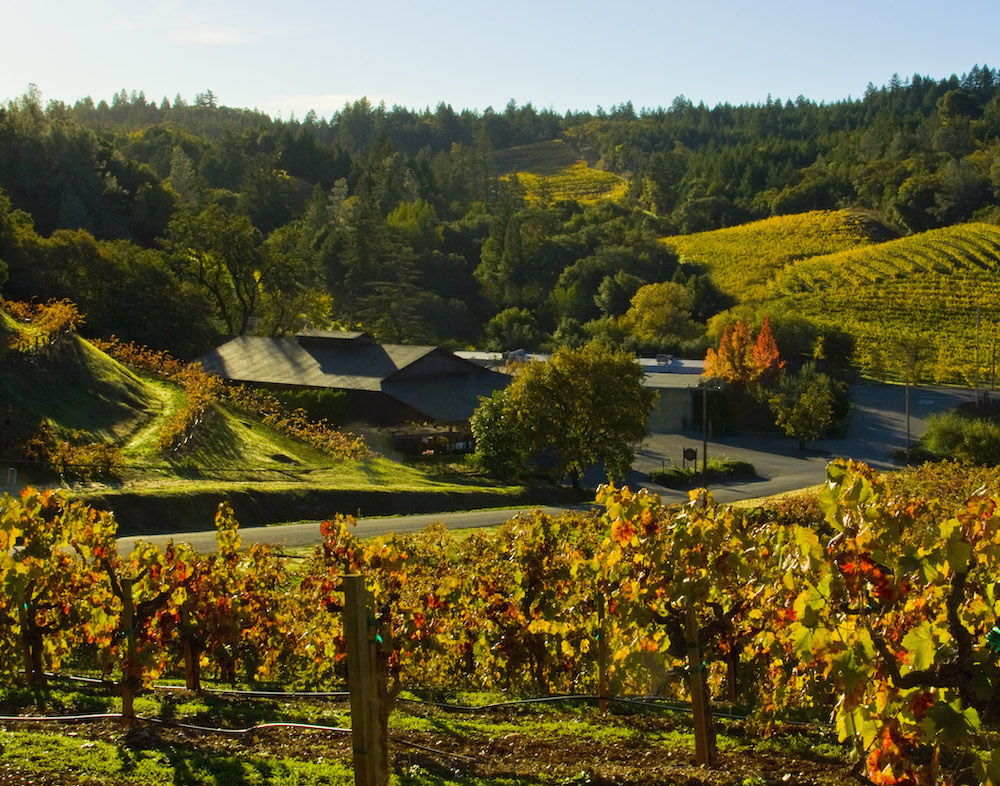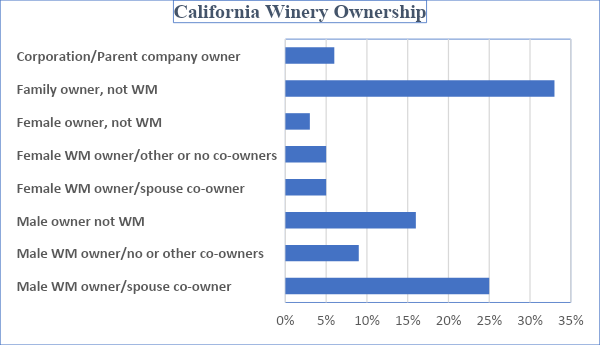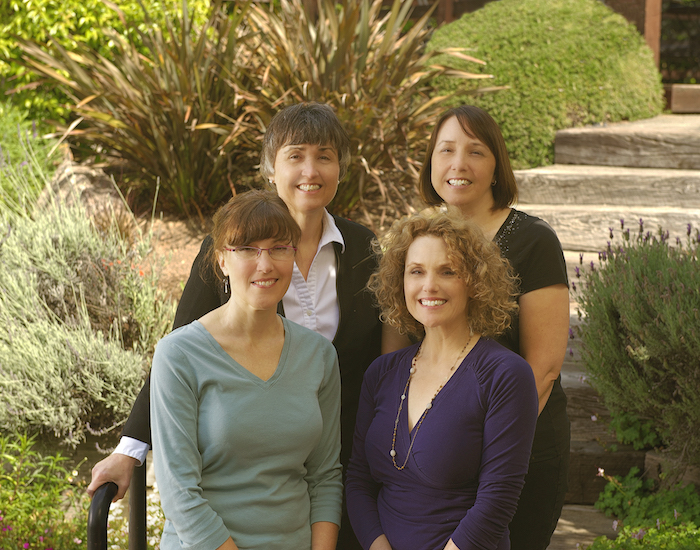
(J Pedroncelli winery, a third-generation family winery located in Sonoma County and now a majority women-owned business)
No formal academic studies to date have addressed the important question of women's ownership of wineries in California, and it seemed to us that it was time to do so. Recent articles have made widely varying claims about such ownership, ranging from 4% of winery owners overall in California1 to 19% of winery owners overall.2 Such disparate figures underscored the importance of providing solid empirical evidence about this key facet of the California's wine industry, which historically has been male dominated.
Our research over the past ten years has provided valuable and accurate data on the percentage of California wineries having lead women winemakers and has illuminated these women's contributions to the wine industry. These studies focused on the women who have the primary responsibility for producing wine at a winery or winemaking facility. The current study focused on the women who are winery owners or co-owners.
The Study and Its Findings
Using the Wines & Vines 2020 Directory and Buyers Guide as the sampling frame, we selected 500 wineries at random from among the some 4200 bonded wineries listed for the state of California, a random selection that gives a 95% confidence level to our results.3 Based on information provided in the Wines & Vines Directory and on winery websites, including pronouns used in describing owners and winemakers, and phone calls and emails to individual wineries, we coded winery ownership into the eight categories indicated below.4,5 For the purposes of the study, a woman was coded as owner or co-owner when she was described as a partner with 50% or more ownership and was actively involved in winery operations.
Categories used for the coding:
- Corporate/Parent Company owner
- Family owner but the winemaker not a family member
- Female owner but not the winemaker
- Female winemaker and owner, co-owner other than spouse or no co-owner
- Female winemaker and owner, spouse is co-owner
- Male owner but not the winemaker
- Male winemaker owner, co-owner other than spouse or no co-owner
- Male winemaker and owner, spouse is co-owner

(Note: WM is an abbreviation for Winemaker)
As can be seen from the Figure, summing across the category of female owner/not winemaker and the two categories of female winemaker/owner, shows that 13% of California wineries report a woman owner. The category of male winemaker owner/spouse co-owner further adds to the number of women who are owners or co-owners, with 25% of the wineries in our study listing a female spouse as co-owner.
The family-owner category in which the winemaker is not a family member was the largest category of winery ownership (33%). This subset of wineries included a sizeable number of wife-husband co-owners with varying levels of participation in core activities of a winery, and some may very well fit our definition of "woman co-owner" or meet the criteria for a "Woman-Owned Business Enterprise (WBE)."6
In total, female ownership or co-ownership represents at least 38% of California wineries, the sum of 13% female ownership or co-ownership and 25% female spouse co-ownership. Wineries in the family-owner category would likely add to this total.
A Promising Area for Increased Women's Ownership
Interestingly, the family-owned category in which the winemaker is not a family member was the largest single category of winery ownership in our study (33%). This category of ownership may hold particular promise as an area of growth for women's participation and recognition as winery owners. An increasing number of women from established California wine families are involved in their families' business and have taken on visible leadership roles.7
As an example, J Pedroncelli, a third-generation Sonoma family winery founded by Joseph Pedroncelli, Sr. in 1927, is now a 70% women-owned business and is WBE certified.6 Julie Pedroncelli St. John, the Vice President of Marketing, and her sisters are the majority shareholders and owners of the winery.

(Bottom row, left to right: Joanna Pedroncelli; Cathy Pedroncelli, Top row, left to right: Julie Pedroncelli St. John; Lisa Blakeley)
Jackson Family Wines, another well-known California family-owned business, is also majority-owned by women. The company is led by Barbara Banke, who co-founded Jackson Family Wines with her late husband, wine icon Jess Jackson. Jackson Family Wines is among the largest U.S. wineries by volume and is the parent company for a number of California wineries, such as La Crema and Arrowood Vineyards and Winery. Katie Jackson, a second-generation proprietor and senior vice-president of corporate responsibility, leads the company's commitment to best practices that reduce climate impact in vineyard and winery operations.8
Concluding Remarks
The wine business remains a male-dominated field in California and globally. Significantly more wineries, for example, have a man rather than a woman as their lead winemaker, both in California and world-wide (Gilbert & Gilbert, 2020),9 and there is greater winery ownership by men overall. Nonetheless, the findings of this empirical study strongly support the view that women have a central role as owners and co-owners of wineries in California.
Footnotes
1. Villano, M. "Women-owned Wineries on the Rise in Wine Country", (Oct. 23, 2019).
2. Wanek, A. "Agility, Endurance, and Vision: What Makes Women Distinctly Suited for Winemaking", (Nov. 4, 2020).
3. Study results obtained from our random sample of 500 wineries drawn from the population of 4200 wineries has a margin of error of ±5% and a confidence level of 95%. The confidence level refers to how confident one can be that the actual sample values obtained in a study fall within the margin of error.
4. Gender identification was determined on the basis of the public information available (e.g., pronouns used in a winery's website profiles).
5. The distribution of California wine regions and winery production ranges were not associated with winery ownership. Approximately half of the wineries were located in the Napa Valley (33%) and the Sonoma/Marin (21%) wine regions, with the South Central Coast (San Luis Obispo and Santa Barbara Counties) region being the third largest (17%). With regard to case production, more than two-thirds of the wineries produced less than 5,000 cases per year, and 9% more than 50,000 cases.
6. A Woman-Owned Business Enterprise (WBE) is defined as one that is at least 51%-owned, operated, and controlled on a daily basis by one or more female American citizens. WBEs are typically certified by a third-party, city, state, or federal agency.
7. Villano, M. "California North Coast Winemakers Pass the Baton to their Daughters", (June 17, 2019).
8. "Familia Torres and Jackson Family Wines Join Efforts to Create Working Group of Wineries to Decarbonize the Industry", (Feb. 28, 2019).
9. Gilbert, L. A., and Gilbert, J. C. (2020). Women Winemakers: Personal Odysseys. Eugene, OR: Luminare Press.
Authors: Lucia Albino Gilbert, Ph.D., and John C. Gilbert, Ph.D., are the authors of the highly acclaimed book, Women Winemakers: Personal Odysseys. Their research on facilitating women's career success in male-dominated scientific fields such as winemaking combines Lucia's academic field of Psychology and John's academic field of Organic Chemistry. Widely published in their respective fields, they are professor emeriti at both The University of Texas at Austin and Santa Clara University. They can be reached at [email protected]. Their research website is www.womenwinemakers.com.










